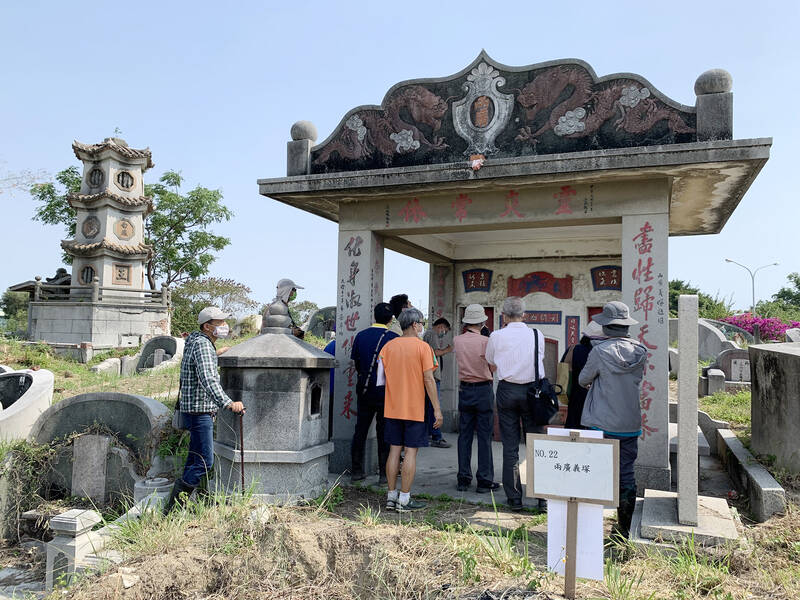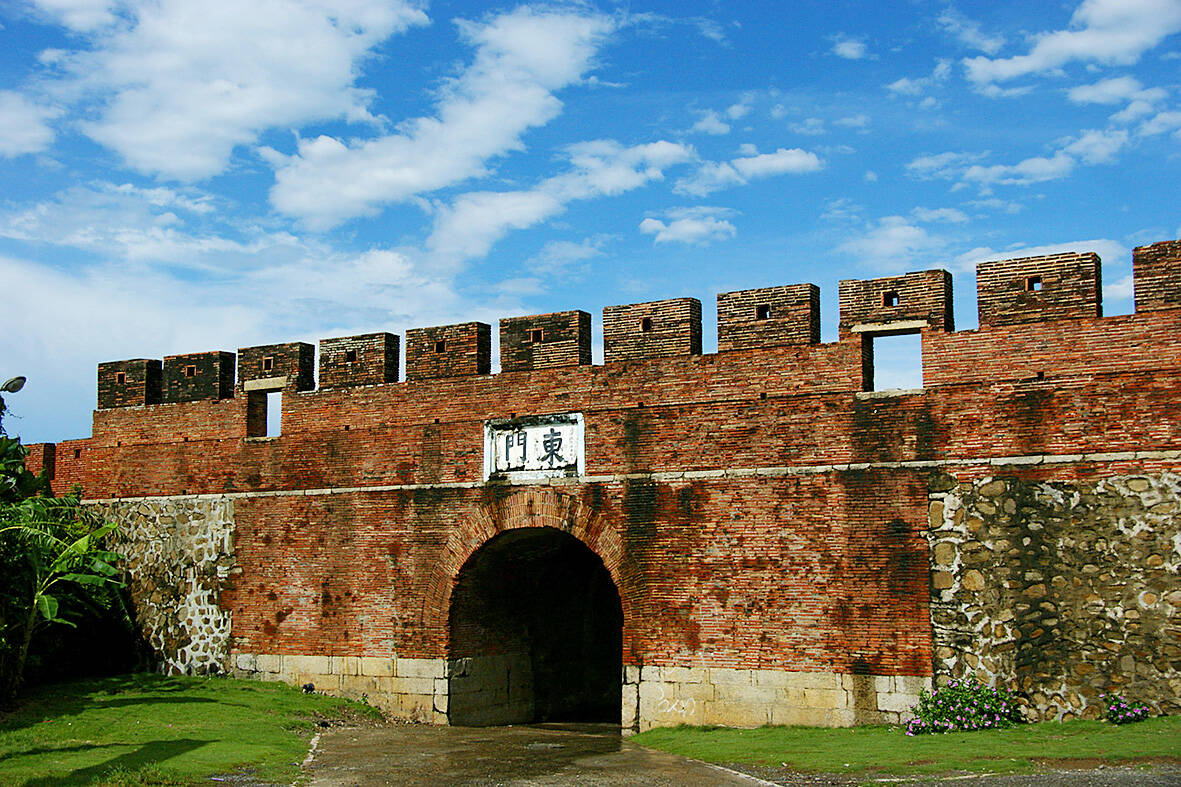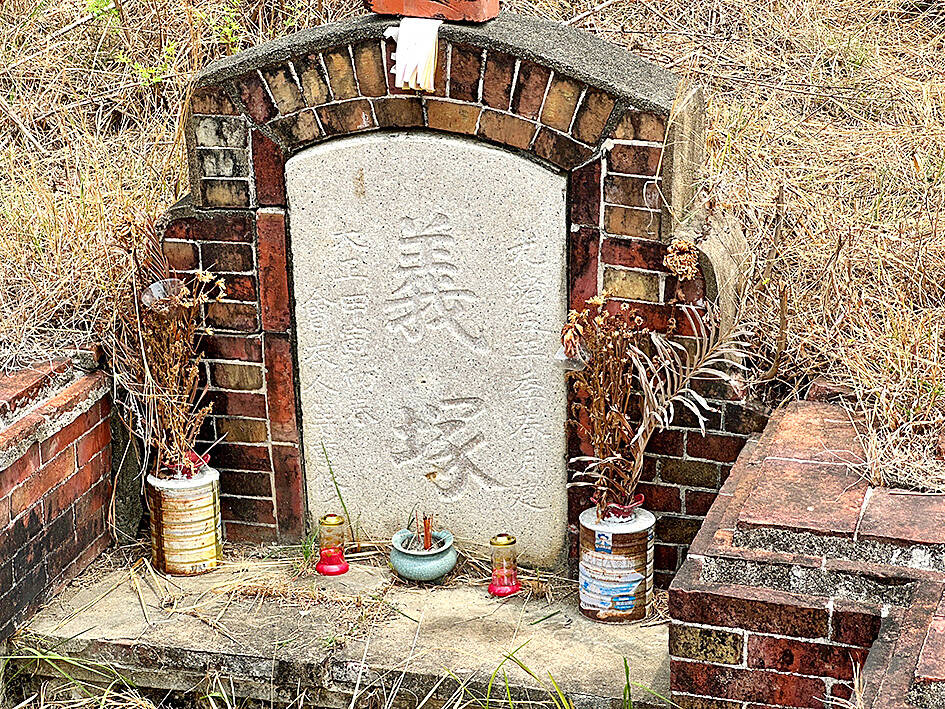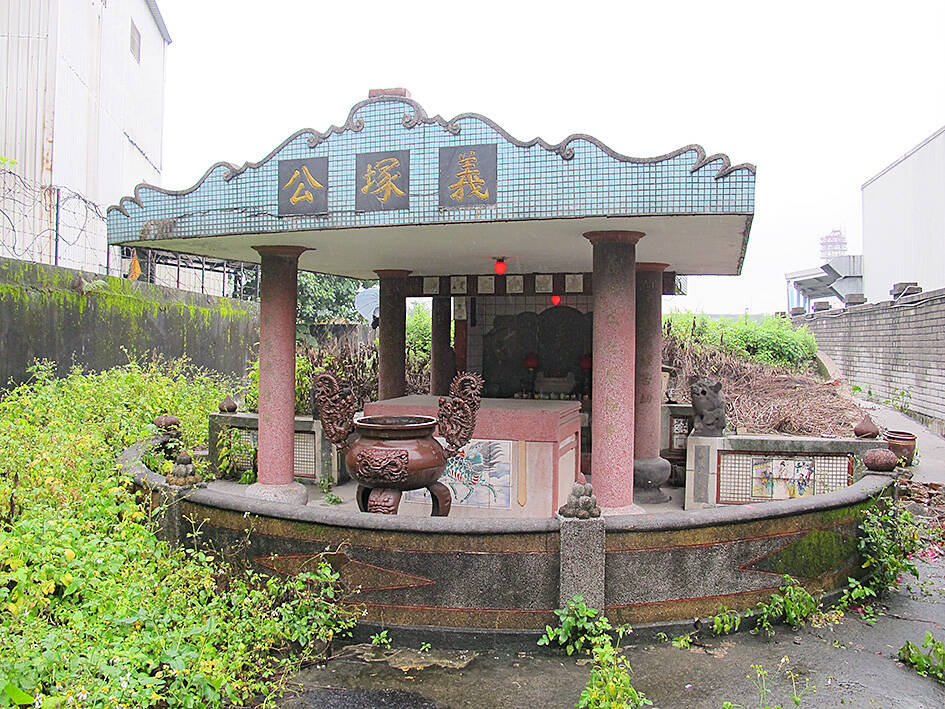May 1 to May 7
Chiang Hsin-tsung’s (江新聰) grandfather would warn him to be careful of the graves outside the east gate of Hengchun (恆春) in Pingtung County. It was on the way to town from their indigenous village, and Chiang was told that the Han inhabitants purposely buried people there so their spirits would scare away their enemies living to the east.
His grandfather was probably referring to the the Lan Army Chu Braves Righteous Grave (蘭軍楚勇義塚), a mass tomb of hundreds of Qing Dynasty soldiers hidden in Hengchun’s First Cemetery. Righteous graves, or charity graves, were constructed by local gentry and government officials across Taiwan during the Qing era to house the remains of mostly unnamed people who had no family or funds for a proper burial.

Photo: Hung Jui-chin, Taipei Times
This righteous grave was paid for in 1879 by military commander Yang Kai-you (楊開友) and 17 local families, including the Chengs (鄭), who renovated it in 1914 and still look after it today.
It is currently under review by the Pingtung County Government for historic site status. With many cemeteries across Taiwan facing relocation, supporters believe the designation is urgently needed to preserve this piece of history, the Liberty Times (Taipei Times’ sister paper) reported on April 19.
Scant information can be found about this tomb, however, aside from a few pages in folklorist Liu Huan-yue’s (劉還月) Historic Road that Runs from East to West: Langqiao and Beinan Trail (貫穿東西的歷史大道: 琅嶠‧卑南道), where Chiang’s account can be found.

Photo courtesy of Wikimedia Commons
The Liberty Times report states that it is a rare example of a well-preserved, Qing-era burial site for soldiers, and that other such sites in Taiwan such as the Hunan Brave ancient tomb in Tamsui (see “Taiwan in Time: The six Braves left behind,” Nov. 29, 2020) are already protected as relics.
CHARITY BURIALS
Since many Han settlers migrated to Taiwan alone during the Qing Dynasty, it was often a question what to do with their corpses if they died unexpectedly, whether it be due to natural disaster, illness, famine, war or other causes. It was costly to ship the bodies back to their ancestral homes in China, which was the preferable option, but there was no family cemetery to bury them in Taiwan, and nobody to care for and worship the tombs. Often they were placed in unmarked graves in the wilderness. There are records of officials paying for the transport of bodies to China, but local burials were more common.

Photo courtesy of Hung Li-wen
The practice of charity burials has existed in China since the Song Dynasty (960-1279), usually carried out by local gentry and government officials. It was considered a virtuous deed to fund such graves, and was one of the various social services the wealthy provided for the less fortunate in Taiwan.
There were two types of righteous graves in Taiwan, according to “Study on charity cemeteries in Qing Taiwan” (清代台灣義塚探討) by Lin Yi-ling (林怡伶): public cemeteries containing many plots, or one large tomb representing tens or hundreds of deceased. They were usually located outside of the cities on unsettled land.
Qing annals show that in the early days of Han settlement in Taiwan, strongmen often seized large swaths of land from peasants and left them without even a place to bury their dead. In response, the government decreed that all uncultivated land, whether public or private, could be used as grave sites, and those who tried to obstruct such burials could be punished. Righteous graves began appearing shortly after.

Photo: Tsai Tsung-hsien, Taipei Times
The earliest recorded righteous cemetery appears in a 1695 annal, located south of Tainan. In 1720, a scholar named Chen Shih-chun (陳士俊) purchased mountainous land in the Fengshan (鳳山) area specifically for poor people to bury their dead.
Lin found a total of 220 recorded righteous graves in Taiwan, more than half of them in Hsinchu and Miaoli counties. These areas were settled later and involved much more violent conflict with indigenous people.
UNNAMED SOLDIERS

Photo: Hsieh Chia-chun, Taipei Times
Lin writes that the problem of unclaimed bodies was exacerbated as the Qing transferred more troops from China to Taiwan during the 1800s. In addition to dying in war, they had trouble adapting to Taiwan’s environment and succumbed to its many diseases.
The number of soldiers grew significantly after the Mudan Incident of 1874, where a series of events culminated in a Japanese punitive expedition against several indigenous villages in the Hengchun peninsula. That same year, the Qing began implementing the “open up the mountains and pacify the savages” (開山撫番) campaign, resulting in increased military casualties.
The Lan Army was originally stationed in Tainan, but it was later tasked with helping the government with its campaigns against the indigenous population. They were moved to Hengchun in 1875 and helped construct the town’s walls, which are still mostly intact. Commander Yang took charge of them in 1877 after several indigenous uprisings took place on the east coast, and stationed them around today’s Taitung City. They returned to Hengchun in December 1878. The bodies in the Lan Army Chu Braves Righteous Grave are likely casualties from these conflicts.
The Hengchun Annals state that the Chu Braves refer to a group of warriors under the Xiang Army (湘軍) brought to Taiwan by general Sun Kai-hua (孫開華). They arrived in Taiwan after 1871 and fought in various battles, including the Dagangkou incident (大港口事件, Karawrawan a demak no Cepo in Amis) against the indigenous Amis in today’s Hualien.
LOCATION MATTERS
Liu writes that at just 1km from Hengchun, the First Cemetery is unusually close to town. It’s also odd that it’s located beyond the east gate — since the sun sets in the west, graves are usually located on that side of the settlement.
He surmises that since there was still much conflict with the indigenous living to the east of Hengchun when the graves were built, the burial grounds had to be located near town. The bodies in the graves weren’t necessarily all soldiers; many Han Taiwanese ventured into indigenous territory to seek profit or hunt treasures, and when they lost their lives, their compatriots had to go collect the bodies. Therefore, it was convenient to place the cemetery on the east side along the major throughway.
In addition, since many of the soldiers died fighting indigenous people, Liu writes it’s possible that the bodies were purposely placed by the east gate to scare their enemies and reassure the Han inhabitants that the spirits of these dead soldiers protected the town.
In addition to the Lan Army Chu Brave tomb, there’s another righteous grave outside the east gate built in 1883 for soldiers from eastern Guangdong. This site is also cared for by the Cheng family since it’s on their land, Liu writes.
Taiwan in Time, a column about Taiwan’s history that is published every Sunday, spotlights important or interesting events around the nation that either have anniversaries this week or are tied to current events.

On April 26, The Lancet published a letter from two doctors at Taichung-based China Medical University Hospital (CMUH) warning that “Taiwan’s Health Care System is on the Brink of Collapse.” The authors said that “Years of policy inaction and mismanagement of resources have led to the National Health Insurance system operating under unsustainable conditions.” The pushback was immediate. Errors in the paper were quickly identified and publicized, to discredit the authors (the hospital apologized). CNA reported that CMUH said the letter described Taiwan in 2021 as having 62 nurses per 10,000 people, when the correct number was 78 nurses per 10,000

As we live longer, our risk of cognitive impairment is increasing. How can we delay the onset of symptoms? Do we have to give up every indulgence or can small changes make a difference? We asked neurologists for tips on how to keep our brains healthy for life. TAKE CARE OF YOUR HEALTH “All of the sensible things that apply to bodily health apply to brain health,” says Suzanne O’Sullivan, a consultant in neurology at the National Hospital for Neurology and Neurosurgery in London, and the author of The Age of Diagnosis. “When you’re 20, you can get away with absolute

May 5 to May 11 What started out as friction between Taiwanese students at Taichung First High School and a Japanese head cook escalated dramatically over the first two weeks of May 1927. It began on April 30 when the cook’s wife knew that lotus starch used in that night’s dinner had rat feces in it, but failed to inform staff until the meal was already prepared. The students believed that her silence was intentional, and filed a complaint. The school’s Japanese administrators sided with the cook’s family, dismissing the students as troublemakers and clamping down on their freedoms — with

As Donald Trump’s executive order in March led to the shuttering of Voice of America (VOA) — the global broadcaster whose roots date back to the fight against Nazi propaganda — he quickly attracted support from figures not used to aligning themselves with any US administration. Trump had ordered the US Agency for Global Media, the federal agency that funds VOA and other groups promoting independent journalism overseas, to be “eliminated to the maximum extent consistent with applicable law.” The decision suddenly halted programming in 49 languages to more than 425 million people. In Moscow, Margarita Simonyan, the hardline editor-in-chief of the